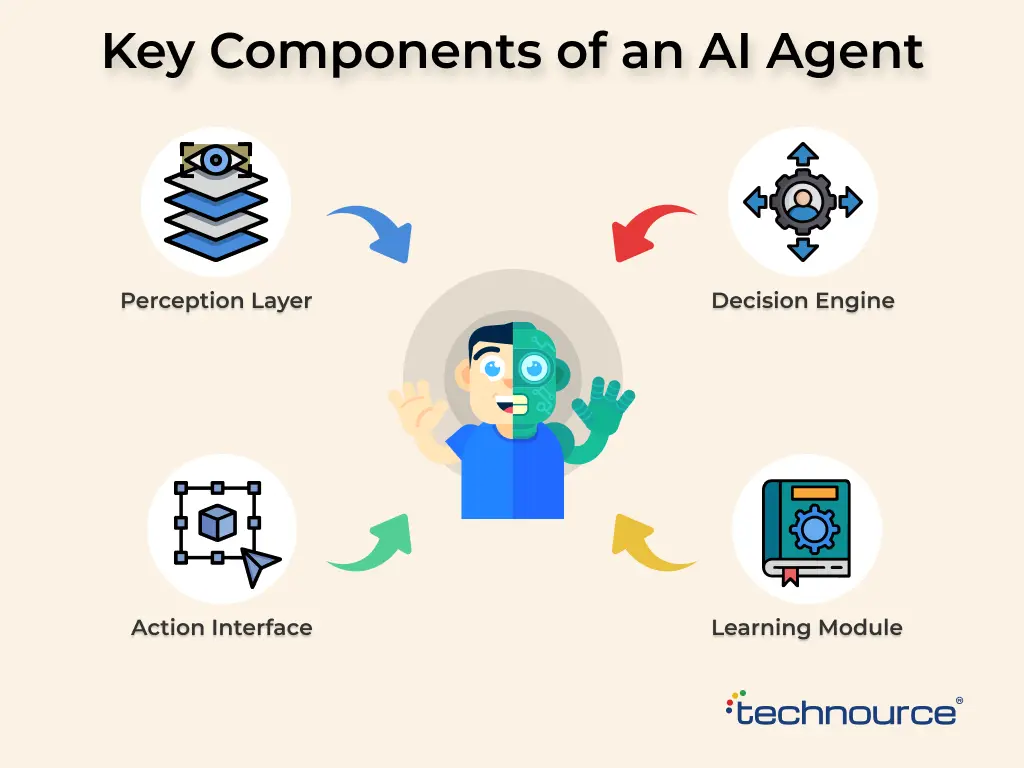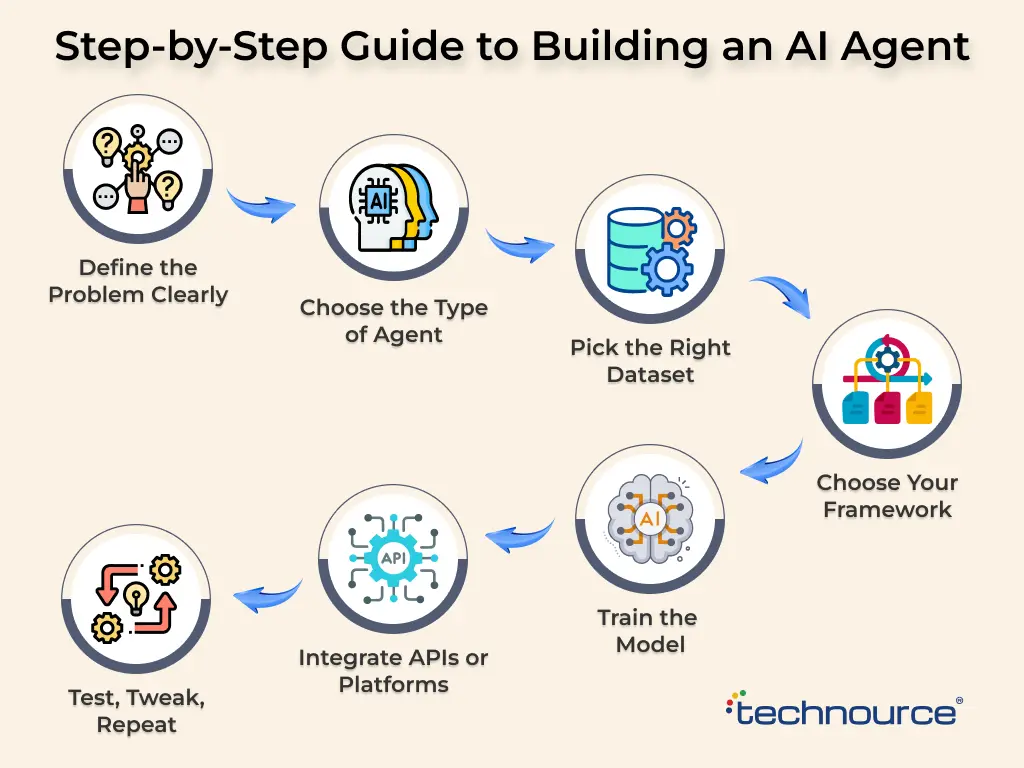How to Develop an AI Agent: A Beginner’s Guide
Quick Summary: Building an AI agent is something that only large tech companies do, but the truth is that today’s tools and services make it pretty easy for developers, startups, and even curious learners to build their own AI. In this beginner’s tutorial, we’re going to take you through what an AI agent is, how it differs from chatbots, what elements it requires, actual tools to work with, best practices to observe, and actual real-world challenges you’ll encounter. If you’re trying AI for the first time or creating a proof-of-concept for your company, this tutorial is here to get it all down in plain language.
The first time I built an AI agent, it wasn’t pretty. It answered questions, sure—but half the time, the answers were out of context, and the other half it simply stalled. But as any learner developer would know, I came to understand: it wasn’t about creating the smartest AI—it was about knowing why AI agents succeeded, and constructing step-by-step from there.
If you’ve ever wondered how to build an AI agent, how to train an AI from scratch, or what tools you’ll need, what all emerging technologies can be associated with the power of AI, you’re in the right place.
With more generative AI agents rising to the scene, there’s never a better time to get your hands dirty and learn how to develop AI. From agent architecture to ethical concerns, we’ll cover it all in plain terms with real tools and examples you can act on. Let’s get started.
What is an AI Agent?
In easy words or in one line, AI agent is a program that can perceive its surroundings, make decisions, and act to pursue certain objectives.
The major differentiator between conventional rule-based bots and AI agents are that AI agents are autonomous and adaptive. They understand concepts and learn knowledge over time, engage with users, and are capable of real-time decision-making.
Think of:
- A self-driving car navigating traffic using AI agents.
- Customer support bots that route queries intelligently.
- Or even autonomous trading agents optimizing financial portfolios.
These are all real-world applications of AI agent architecture in action.
Have you heard about Artificial General Intelligence? Know more about it in detail
Key Components of an AI Agent
Every AI agent, no matter how simple, has some common building blocks:
-
-
Perception Layer
-
This is how the agent “sees” the world. It can include:
-
-
- Cameras or sensors (for robotics)
- Text input (for chatbots)
- API data streams (for web agents)
-
Decision Engine
-
This is generally powered by ML models or rule-based systems. It processes inputs, applies logic, and chooses the best form of action.
-
-
Learning Module
-
If reinforcement learning or other adaptive systems is your choice at work, this is the brain that keeps evolving. It shows improvement based on feedback or rewards.
-
-
Action Interface
-
Finally, the agent has to act—send a reply, navigate a route, trigger an event. The Action Module does just that.
Step-by-Step Guide to Building a Simple AI Agent
Whether you’re an individual developer or a custom mobile app development company, here’s a beginner-friendly path to build your first AI agent.
Step 1: Define the Problem Clearly
Don’t start with “I want AI.” Start with:
- “I want an agent that answers HR questions.”
- “I want an AI that organizes support tickets.”
Clarity here will save you time and money.
Step 2: Choose the Type of Agent
- Reactive agents: No memory. Quick responders. (Good for bots)
- Goal-based agents: Makes decisions toward objectives. (e.g. AI trading)
- Learning agents: Improve over time. (e.g. recommendation systems)
Step 3: Pick the Right Dataset
Want to train your own AI? You’ll need conversation logs.
Building a recommendation agent? You need behavior data.
Start small—use open-source datasets from Kaggle, Hugging Face, or UCI Repository and leverage generative ai for business.
Step 4: Choose Your Framework
- For NLP: Rasa, spaCy, LangChain
- For ML/AI: TensorFlow, PyTorch
- For full-stack AI agents: Auto-GPT, AgentGPT
Step 5: Train the Model
This step depends on your agent’s goal:
- Text Classification (for chatbots)
- Intent Recognition
- Decision Trees or Neural Networks for Pattern Analysis
Step 6: Integrate APIs or Platforms
Once your open ai model behaves as expected:
- Connect it to Twilio, Slack, or your CRM
- Or deploy on cloud platforms like AWS, Google Cloud, or Azure
Step 7: Test. Tweak. Repeat.
Build small. Test. Break it. Improve.
This loop makes the AI smarter, not just your codebase.
Tools & Frameworks for AI Agent Development
Here are some tried-and-tested tools for building AI agents:
| Tool | Use Case | Best For |
|---|---|---|
| LangChain | Building LLM-based agents | Chatbots, Workflow agents |
| Rasa | Open-source conversational AI | Enterprise bots |
| Auto-GPT | Autonomous GPT agents | Research, Automation |
| Hugging Face | Pre-trained models | Quick deployment |
| TensorFlow | ML & DL modeling | Image/text-based agents |
| Gradio | Frontend for ML apps | Demos and prototypes |
Best Practices for First-Time AI Developers
-
- Start Simple
Begin with a chatbot development or recommendation agent before aiming for full autonomy.
-
- Use Pre-trained Models
Don’t reinvent the wheel. Utilize BERT, GPT-3, or T5 for tasks such as summarization, question answering, or intent detection.
-
- Document Everything
Track each training attempt, dataset, and outcome. Debugging AI requires visibility.
-
- Plan for Feedback Loops
An AI agent that learns is only as good as the feedback you provide.
Challenges and Ethical Considerations
While building your first AI agent is exciting, you must keep these in mind, especially if you’re using AI in mobile app development, where performance, integration, and user experience are critical.
-
-
Data Privacy
-
Make sure your training data is anonymized and ethically sourced.
-
-
Model Bias
-
AI agents can reflect the biases of the data they’re trained on. Regular evaluation is crucial.
-
-
Explainability
-
Especially in regulated industries like healthcare or finance, your AI agent must be explainable.
-
-
Reliability
-
Never trust an AI blindly. Always keep humans in the loop—especially in decision-making scenarios.
Real-World Use Cases and Stats
To give you a sense of how impactful AI agents are in the real world:
- 65% of companies using AI agents in customer support report 25–40% cost reduction.
- 70% of enterprise decision-makers say AI agents improve employee efficiency by automating repetitive tasks.
- LangChain GitHub repo crossed 60K+ stars, showing massive developer adoption for AI agents.
Don’t miss our exclusive guide on: Responsible AI: A CEO’s Perspective
Conclusion
Developing an AI agent nowadays is no longer the prerogative of tech giants or PhD graduates. With open models, friendly tools, and growing numbers of willing participants to help, individual founders and tiny teams can already develop intelligent systems.
Whether you’re looking for AI development services to develop a chatbot to handle customer support queries, automate business workflows, or just tinker with generative AI, it all starts with a bit of curiosity and a willingness to build, experiment, and learn more.
Here at Technource, we’ve assisted startups and companies in building their AI software journey from basic bots to full-fledged intelligent systems.
FAQs Related to How to Build an AI Agent
An AI agent is a computer program that can sense its world, make choices, and act to attain goals. AI agents are different from regular software because they can learn and evolve over time. A chatbot is rule-based and provides pre-set answers. An AI agent can comprehend context, learn from experience, and make sophisticated decisions. Python is the most widely used language due to having immense libraries (TensorFlow, PyTorch, scikit-learn) and simplicity. Applications such as LangChain, Rasa, Auto-GPT, TensorFlow, and Hugging Face are used to develop AI systems, based on your application. It can take as little as a few days to several weeks for a simple agent, based on complexity, availability of data, and level of experience.
Request Free Consultation
Amplify your business and take advantage of our expertise & experience to shape the future of your business.











